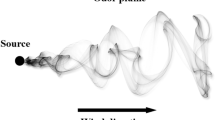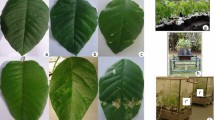Abstract
Emissions of volatile organic compounds (VOCs) from sunflower (Helianthus annuus L. cv. giganteus) were measured in a continuously stirred tank reactor. The compounds predominantly emitted from sunflower were: isoprene, the monoterpenes α-pinene, β-pinene, sabinene, 3-carene and limonene, an oxygenated terpene, not positively identified so far and the sesquiterpene β-caryophyllene. Emission rates ranged from 0.8 x 10−16 to 4.3 x 10 −15 mol cm−2 s−1 at a temperature of 25°C and at a light intensity of 820 µEm−2 s−1. A dependence of the emission rates on temperature as well as on light intensity was observed. The emission rates of α-pinene, sabinene and thujene from beech (Fagus sylvatica L.) were also affected by temperature as well as by light intensity. Our results suggest that an emission algorithm for all compounds emitted from sunflower and beech has to consider temperature and light intensity simultaneously. The observations strongly indicate that the emissions of VOCs from sunflower and beech are in part closely coupled to the rate of biosynthesis and in part originate from diffusion out of pools. The emission rates can be described by an algorithm that combines the model given by Tingey and coworkers with the algorithm given by Guenther and coworkers after slight modification.
Similar content being viewed by others
References
Arey, J., Winer, A. M., Atkinson, R., Aschmann, S. M., Long, W. D., and Morrison, C. L., 1991: The emission of (Z)-3-hexen-1-ole, (Z)-3-hexenyl Acetate and other oxygenated hydrocarbons from agricultural plant species, Atmos.Environ. 25A, 1063–1075.
Bertin, N., Staudt, M., Hansen, U., Seufert, G., Ciccioli, P., Foster, P., Fugit, J. L., and Torres, L., 1997: The BEMA-project: Diurnal and seasonal course of monoterpene emissions from Quercus ilex (L.) under natural conditions – application of light and temperature algorithms, Atmos.Environ., in press.
Caemmerer von, S. and Farquhar, G. D., 1981: Some relationships between the biochemistry of photosynthesis and the gas exchange of leaves, Planta 153, 376–387.
Delwiche, C. F. and Sharkey, T. D., 1993: Rapid appearance of 13C in biogenic isoprene when 13CO2 is fed to intact leaves, Plant, Cell Environ. 16, 587–591.
Fehsenfeld, F., Calvert, J., Fall, R., Goldan, P., Guenther, A. B., Hewitt, C. N., Lamb, B., Liu, S., Trainer, M., Westberg, H., and Zimmerman, P. R., 1992: Emissions of volatile organic compounds from vegetation and the implications for atmospheric chemistry, Global Biochem.Cycles 6(4), 389–430.
Gleizes, M., Pauly, G., Bernard-Dagan, C., and Jaques, R., 1980: Effects of light on terpene hydrocarbon synthesis in Pinus Pinaster, Physiol.Plant. 50, 16–20.
Goldan, P. D., Kuster, W. C., and Fehsenfeld, F. C., 1995: Hydrocarbon measurements in the Southeastern United States: The Rural Oxidants in the Southern Environment (ROSE) Program 1990, J.Geophys.Res. 100(D12), 25945–25963.
Guenther, A. B., Monson, R. K., and Fall, R., 1991: Isoprene and monoterpene emission rate variability: Observations with eucalyptus and emission rate algorithm development, J.Geophys.Res. 96, 10799–10808.
Guenther, A. B., Zimmerman, P. R., Harley, P. C., Monson, R. K., and Fall, R., 1993: Isoprene and monoterpene emission rate variability: Model evaluation and sensitivity analyses, J.Geophys. Res. 98, 12609–12617.
Hoffmann, T., 1995: An adsorptive preconcentration technique including oxidant scavenging for the measurement of reactive natural hydrocarbons in ambient air, Fres.J.Anal.Chem. 351, 41–47.
Isidorov, V. A., Zenkevich, I. G., and Ioffe, B. V., 1985: Volatile organic compounds in the atmosphere of forests, Atmos.Environ. 19, 1–8.
Janson, R., 1993: Monoterpene emissions from Scots Pine and Norwegian Spruce, J.Geophys.Res. 98(D2), 2839–2850.
Kahl, J., Hoffmann, T., and Klockow, D., 1997: Emission of biogenic hydrocarbons from plants: Characterization and application of a plant enclosure chamber, Proc.Eurotrac Symp.1996, in press.
Khalil, M. A. K. and Rasmussen, R. A., 1992: Forest hydrocarbon emissions: Relationships between fluxes and ambient concentrations, J.Air Waste Manage.Assoc. 42, 810–813.
Kesselmeier, J., Schäfer, L., Ciccioli, P., Brancaleoni, E., Cecinato, A., Frattoni, M., Foster, P., Jacob, V., Denis, J., Fugit, J. L., Dutaur, L., Torres, L., 1996: Emission of monoterpenes and isoprene from a mediterranean oak species Quercus ilex L. measured within the BEMA (biogenic emissions in the mediterranean area) project, Atmos.Environ. 30, 1841–1850.
König, G., Brunda, M., Puxbaum, H., and Rudolph, J., 1995: Relative contribution of oxygenated hydrocarbons to the total biogenic VOC emissions of selected mid-European agricultural and natural plant species, Atmos.Environ. 29, 861–874.
Lerdau, M., Dilts, S. B., Westberg, H., Lamb, B. A., Allwine, E. J., 1994: Monoterpene emission from Ponderosa Pine, J.Geophys.Res. 99(D8), 16609–16615.
McGarvey, D. J. and Croteau, R., 1995: Terpenoid metabolism, The Plant Cell 7, 1015–1026.
Mohr, H. and Schopfer, P., 1985: Lehrbuch der Pflanzenphysiologie, Springer-Verlag, Berlin, p. 119.
Neubert, A., Kley, D., Wildt, J., Segschneider, H.-J., and Förstel, H., 1993: Uptake of NO, NO2, and O3 by sunflower (Helianthus annuus L.) and tobacco plants (Nicotiana tabacum L.): dependence on stomatal conductivity, Atmos.Environ. 27A, 2137–2145.
Sharkey, D. T., Loreto, F., and Delwiche, C. F., 1991: The biochemistry of isoprene emission from leaves during photosynthesis, in T. D. Sharkey, E. A. Holland, H. A. Mooney (eds), Trace Gas Emissions by Plants, Academic Press, New York, pp. 153–184.
Staudt, M. and Seufert, G., 1995: Light dependent emission of monoterpenes by Holm Oak (Quercus ilex L.), Naturwissenschaften 82, 89–92.
Street, R. A., Duckham, S. C., Boissard, C., and Hewitt, C. N., 1994: Biogenic terpenoid emissions from vegetation in Europe – A contribution to subproject BIATEX, in P. M. Borrell et al. (eds), Proceedings of EUROTRACSymposium' 94, Academic Publishing, The Hague, The Netherlands, pp. 480–484.
Tingey, D. T., Manning, M., Grothaus, L.C., and Burns, W. F., 1979: Influence of light and temperature on isoprene emission rates from live oak, Physiol.Plant. 47, 112–118.
Tingey, D. T., Manning, M., Grothaus, L.C., and Burns, W. F., 1980: Influence of light and temperature on monoterpene emission rates from Slash Pine, Plant Physiol. 65, 797–801.
Tingey, D. T., Turner, D. P., Weber, J. A., 1991: Factors controlling the emissions of monoterpenes and other volatile organic compounds, in T. D. Sharkey, E. A. Holland, H. A. Mooney (eds), Trace Gas Emissions by Plants, Academic Press, New York, pp. 93–119.
Wildt, J., Kley, D., Rockel, A., Rockel, P., and Segschneider, H. J., 1997: Emission of NO from several higher plant species, J.Geophys.Res. 102, 5919–5927.
Winer, A. M., Arey, J., Atkinson, R., Aschmann, S. M., Long, W. D., Morrison, C. L., Olszyk, M., 1992: Emission rates of organics from vegetation in California's Central Valley, Atmos.Environ. 26A, 2647–2659.
Yokouchi, Y. and Ambe, Y., 1984: Factors affecting the emission of monoterpenes from red pine (Pinus densiflora), Plant Physiol. 75, 1009–1012.
Rights and permissions
About this article
Cite this article
Schuh, G., Heiden, A.C., Hoffmann, T. et al. Emissions of Volatile Organic Compounds from Sunflower and Beech: Dependence on Temperature and Light Intensity. Journal of Atmospheric Chemistry 27, 291–318 (1997). https://doi.org/10.1023/A:1005850710257
Issue Date:
DOI: https://doi.org/10.1023/A:1005850710257




